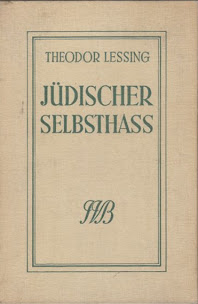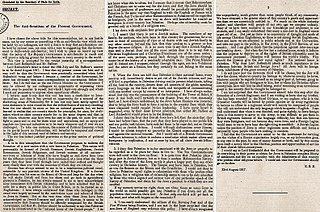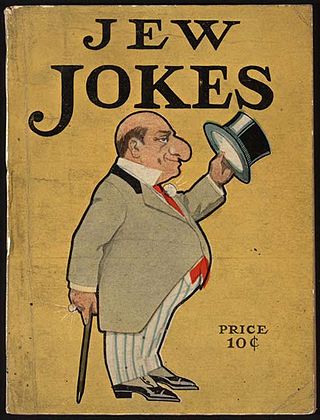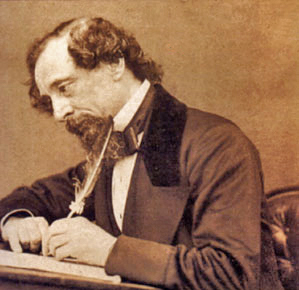Antisemitism is hostility to, prejudice towards, or discrimination against Jews. A person who holds such positions is called an antisemite. Antisemitism is considered to be a form of racism.

The Merchant of Venice is a play by William Shakespeare, believed to have been written between 1596 and 1598. A merchant in Venice named Antonio defaults on a large loan provided by a Jewish moneylender, Shylock.

Oliver Twist; or, The Parish Boy's Progress, is the second novel by English author Charles Dickens. It was originally published as a serial from 1837 to 1839, and as a three-volume book in 1838. The story follows the titular orphan, who, after being raised in a workhouse, escapes to London, where he meets a gang of juvenile pickpockets led by the elderly criminal Fagin, discovers the secrets of his parentage, and reconnects with his remaining family.
The history of antisemitism, defined as hostile actions or discrimination against Jews as a religious or ethnic group, goes back many centuries, with antisemitism being called "the longest hatred". Jerome Chanes identifies six stages in the historical development of antisemitism:
- Pre-Christian anti-Judaism in Ancient Greece and Rome which was primarily ethnic in nature
- Christian antisemitism in antiquity and the Middle Ages which was religious in nature and has extended into modern times
- Muslim antisemitism which was—at least in its classical form—nuanced, in that Jews were a protected class
- Political, social and economic antisemitism during the Enlightenment and post-Enlightenment Europe which laid the groundwork for racial antisemitism
- Racial antisemitism that arose in the 19th century and culminated in Nazism
- Contemporary antisemitism which has been labeled by some as the new antisemitism
Religious antisemitism is aversion to or discrimination against Jews as a whole, based on religious doctrines of supersession that expect or demand the disappearance of Judaism and the conversion of Jews, and which figure their political enemies in Jewish terms. This often has led to false claims against Judaism and religious antisemitic canards. It is sometimes called theological antisemitism.

Svengali is a character in the novel Trilby which was first published in 1894 by George du Maurier. Svengali is a man who seduces, dominates and exploits Trilby, a young half-Irish girl, and makes her into a famous singer.

Henry Harland was an American novelist and editor.

Self-hating Jew or self-loathing Jew, transliterated in Hebrew as auto-antisemitism, is a term which is used to describe Jews whose views are perceived as antisemitic. The concept gained widespread currency after Theodor Lessing's 1930 book Der jüdische Selbsthaß, which sought to explain a perceived inclination among Jewish intellectuals, toward inciting antisemitism, by stating their views about Judaism. The term is said to have become "something of a key term of opprobrium in and beyond Cold War-era debates about Zionism".

Fagin the Jew is a graphic novel by American cartoonist Will Eisner.
Żydokomuna is an anti-communist and antisemitic canard, or a pejorative stereotype, suggesting that most Jews collaborated with the Soviet Union in importing communism into Poland, or that there was an exclusively Jewish conspiracy to do so. A Polish language term for "Jewish Bolshevism", or more literally "Jewish communism", Żydokomuna is related to the "Jewish world conspiracy" myth.

Jewish American literature holds an essential place in the literary history of the United States. It encompasses traditions of writing in English, primarily, as well as in other languages, the most important of which has been Yiddish. While critics and authors generally acknowledge the notion of a distinctive corpus and practice of writing about Jewishness in America, many writers resist being pigeonholed as "Jewish voices." Also, many nominally Jewish writers cannot be considered representative of Jewish American literature, one example being Isaac Asimov.

Racial antisemitism is prejudice against Jews based on a belief or assertion that Jews constitute a distinct race that has inherent traits or characteristics that appear in some way abhorrent or inherently inferior or otherwise different from the traits or characteristics of the rest of a society. The abhorrence may find expression in the form of discrimination, stereotypes or caricatures. Racial antisemitism may present Jews, as a group, as a threat in some way to the values or safety of a society. Racial antisemitism can seem deeper-rooted than religious antisemitism, because for religious antisemites conversion of Jews remains an option and once converted the "Jew" is gone. In the context of racial antisemitism Jews cannot get rid of their Jewishness.

Fagin is a fictional character and the secondary antagonist in Charles Dickens's 1838 novel Oliver Twist. He is one of the most notorious antisemitic portraits in English literature. In the preface to the novel, he is described as a "receiver of stolen goods". He is the leader of a group of children whom he teaches to make their livings by pickpocketing and other criminal activities, in exchange for shelter. A distinguishing trait is his constant and insincere use of the phrase "my dear" when addressing others. At the time of the novel, he is said by another character, Monks, to have already made criminals out of "scores" of children. Nancy, who is the lover of Bill Sikes, is confirmed to be Fagin's former pupil.

Anti-Zionism is opposition to Zionism. Although anti-Zionism is a heterogeneous phenomenon, all its proponents agree that the creation of the modern State of Israel, and the movement to create a sovereign Jewish state in the region of Palestine – the biblical Land of Israel – was flawed or unjust in some way.

Stereotypes of Jews are generalized representations of Jews, often caricatured and of a prejudiced and antisemitic nature.
Economic antisemitism is antisemitism that uses stereotypes and canards that are based on negative perceptions or assertions of the economic status, occupations or economic behaviour of Jews, at times leading to various governmental policies, regulations, taxes and laws that target or which disproportionately impact the economic status, occupations or behaviour of Jews.

The topic of racism in the work of Charles Dickens has been discussed in scholarly circles, increasingly so in the 20th and 21st centuries. While Dickens was known to be highly sympathetic to the plight of the poor and disadvantaged in British society, like many other authors of the period he expressed attitudes which have been interpreted as racist and xenophobic in his journalism and works. Dickens frequently defended the privileges held by Europeans in overseas colonies and was dismissive of what he termed "primitive" cultures. The Oxford Dictionary of English Literature describes Dickens as a nationalist who frequently stigmatised non-European cultures.

Shylock is a fictional character in William Shakespeare's play The Merchant of Venice. A Venetian Jewish moneylender, Shylock is the play's principal antagonist. His defeat and conversion to Christianity form the climax of the story.
Zionist antisemitism is the phenomenon in which individuals, groups, or governments support the Zionist movement and the State of Israel while they simultaneously hold antisemitic views about Jews. In some cases, Zionism may be promoted for explicitly antisemitic reasons. The prevalence of antisemitism has been widely noted within the Christian Zionist movement, whose adherents may hold antisemitic and supersessionist beliefs about Jews while also supporting Zionism for eschatological reasons. Antisemitic right-wing nationalists, particularly in Europe and the United States, sometimes support the Zionist movement because they wish that Jews be expelled or that they emigrate to Israel. The Israeli government's alleged collaboration with antisemitic politicians abroad has been criticized as an example of Zionist antisemitism. Anti-Zionists have criticized the Zionist movement for its alleged complicity with or its alleged capitulation to antisemitism since its inception, with some anti-Zionists also referring to Zionism as a form of antisemitism.













